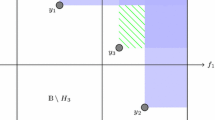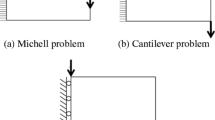Abstract
At present, black-box and simulation-based optimization problems with multiple objective functions are becoming increasingly common in the engineering context. In many cases, the functional relationships that define the objective and constraints are only known as black-boxes, cannot be differentiated accurately, and may be subject to unexpected failures. Directional direct search techniques, in particular the direct multisearch (DMS) methodology, may be applied to identify Pareto fronts for such problems. In this work, we propose a mechanism for adaptively selecting search directions in the DMS framework, with the goal of reducing the number of black-box evaluations required during the optimization. Our method relies on the concept of simplex derivatives in order to define search directions that are optimal for a local, linear model of the objective function. We provide a detailed description of the resulting algorithm and offer several practical recommendations for efficiently solving the associated subproblems. The overall performance in an academic context is assessed via a standard benchmark. Through a realistic case study, involving the bi-objective design optimization of a mechatronic quarter-car suspension, the performance of the novel method in a multidisciplinary engineering setting is tested. The results show that our method is competitive with standard implementations of DMS and other state-of-the-art multi-objective direct search methods.







Similar content being viewed by others
Notes
Strictly speaking, this is a deviation from the default settings for these algorithms.
References
Audet C, Hare W (2017) Derivative-free and blackbox optimization, 1st edn. Springer Series in Operations Research and Financial Engineering, Springer, Cham
Audet C, Savard G, Zghal W (2008) Multiobjective optimization through a series of single-objective formulations. SIAM J Optim 19(1):188–210
Audet C, Savard G, Zghal W (2010) A mesh adaptive direct search algorithm for multiobjective optimization. Eur J Oper Res 204(3):545–556
Audet C, Bigeon J, Cartier D, Le Digabel S, Salomon L (2021) Performance indicators in multiobjective optimization. Eur J Oper Res 292(2):397–422
Campana EF, Diez M, Liuzzi G, Lucidi S, Pellegrini R, Piccialli V, Rinaldi F, Serani A (2018) A multi-objective DIRECT algorithm for ship hull optimization. Comput Optim Appl 71(1):53–72
Cocchi G, Liuzzi G, Papini A, Sciandrone M (2018) An implicit filtering algorithm for derivative-free multiobjective optimization with box constraints. Comput Optim Appl 69(2):267–296
Coello Coello CA, Lechuga MS (2002) MOPSO: a proposal for multiple objective particle swarm optimization. In: Proceedings of the 2002 congress on evolutionary computation. IEEE, vol 2, pp 1051–1056
Coello Coello CA, Lamont GB, van Veldhuizen DA (2007) Evolutionary algorithms for solving multi-objective problems, 2nd edn. Springer, New York
Conn AR, Scheinberg K, Vicente LN (2008) Geometry of sample sets in derivative-free optimization: polynomial regression and underdetermined interpolation. IMA J Numer Anal 28(4):721–748
Conn AR, Scheinberg K, Vicente LN (2009) Introduction to derivative-free optimization. Society for Industrial and Applied Mathematics, Philadelphia
Custódio AL, Madeira JFA (2018) MultiGLODS: global and local multiobjective optimization using direct search. J Glob Optim 72(2):323–345
Custódio AL, Vicente LN (2007) Using sampling and simplex derivatives in pattern search methods. SIAM J Optim 18(2):537–555
Custódio AL, Madeira JFA, Vaz AIF, Vicente LN (2011) Direct multisearch for multiobjective optimization. SIAM Journal on Optimization 21(3):1109–1140, errata at http://www.mat.uc.pt/~lnv/papers/errata-dms.pdf
Deb K, Pratap A, Agarwal S, Meyarivan T (2002) A fast and elitist multiobjective genetic algorithm: NSGA-II. IEEE Trans Evol Comput 6(2):182–197
Dedoncker S, Desmet W, Naets F (2021) Generating set search using simplex gradients for bound-constrained black-box optimization. Comput Optim Appl 79(1):35–65
Dolan ED, Moré JJ (2002) Benchmarking optimization software with performance profiles. Math Program 91(2):201–213
Fliege J, Svaiter BF (2000) Steepest descent methods for multicriteria optimization. Math Methods Oper Res (ZOR) 51(3):479–494
Frimannslund L, Steihaug T (2007) A generating set search method using curvature information. Comput Optim Appl 38(1):105–121
Kelley CT (2011) Implicit filtering. Society for Industrial and Applied Mathematics, Philadelphia
Kolda TG, Lewis RM, Torczon V (2003) Optimization by direct search: new perspectives on some classical and modern methods. SIAM Rev 45(3):385–482
Liuzzi G, Lucidi S, Rinaldi F (2016) A derivative-free approach to constrained multiobjective nonsmooth optimization. SIAM J Optim 26(4):2744–2774
Marler RT, Arora JS (2004) Survey of multi-objective optimization methods for engineering. Struct Multidiscip Optim 26(6):369–395
Miettinen K (1998) Nonlinear multiobjective optimization. Springer, US
Ryu JH, Kim S (2014) A derivative-free trust-region method for biobjective optimization. SIAM J Optim 24(1):334–362
Suppapitnarm A, Seffen KA, Parks GT, Clarkson P (2000) A simulated annealing algorithm for multiobjective optimization. Eng Optim 33(1):59–85
Wong JY (2008) Theory of ground vehicles, 4th edn. Wiley, New York
Zapotecas-Martínez S, Coello Coello CA (2016) MONSS: a multi-objective nonlinear simplex search approach. Eng Optim 48(1):16–38
Acknowledgements
This work was supported by the Research Fund KU Leuven and by Flanders Make, the strategic research center for the manufacturing industry.
Author information
Authors and Affiliations
Corresponding author
Additional information
Publisher's Note
Springer Nature remains neutral with regard to jurisdictional claims in published maps and institutional affiliations.
Technical results used in the proof of Theorem 2
Technical results used in the proof of Theorem 2
The first step is to recognize that the distance function has the following subadditivity property.
Lemma 1
(Subadditivity of the distance function) Let \({\mathcal {W}}_1,{\mathcal {W}}_2 \subset {\mathbb {R}}^n\) be closed, and let \(\mathbf {w} \in {\mathbb {R}}^n\) be an arbitrary vector. Then
Proof
For arbitrary \(\mathbf {w}_1 \in {\mathcal {W}}_1, \mathbf {w}_2 \in {\mathcal {W}}_2\), and \(\mathbf {w} \in {\mathbb {R}}^n\) we have
by the triangle inequality. Since this holds for any \(\mathbf {w}_1\) and \(\mathbf {w}_2\), it must also be the case that
\(\square\)
The next lemma is used to show that a specific hyperplane is supporting for a convex set.
Lemma 2
(Supporting hyperplane for convex sets) Let \({\mathcal {W}} \subset {\mathbb {R}}^n\) be closed and convex. Let \(\mathbf {w}^*\) be the minimizer
Then, for arbitrary \(\mathbf {w}\in {\mathcal {W}}\), the vector \(\mathbf {w}^*\) defines a supporting hyperplane:
Proof
Since the norm minimization is a convex problem, \(\mathbf {w}^*\) exists and is a unique minimizer. By convexity, for any \(\mathbf {w}\in {\mathcal {W}}\) and \(\alpha \in [0,1]\) we have
The definition of \(\mathbf {w}^*\) implies
Hence
as long as \(\alpha > 0\). Taking the limit \(\alpha \rightarrow 0\), we find
\(\square\)
Intuitively, one might expect the optimal separation of two convex sets to occur when they are diametrically opposed across the origin. Such a situation indeed achieves an equality of the Eq. (40), as the next lemma demonstrates.
Lemma 3
(Distance between diametrically opposed convex sets) Let \({\mathcal {W}}_1,{\mathcal {W}}_2 \subset {\mathbb {R}}^n\) be closed and convex. Let \(\mathbf {w}_1^*\) and \(\mathbf {w}_2^*\) be the respective minimizers
Suppose \(\mathbf {w}_1^*,\mathbf {w}_2^*\ne \mathbf {0}\) and that \(\mathbf {w}_1^*= -\alpha \mathbf {w}_2^*\) with \(\alpha > 0\). Then
Proof
For arbitrary \(\mathbf {w}_1 \in {\mathcal {W}}_1, \mathbf {w}_2 \in {\mathcal {W}}_2\) we have
Therefore,
since the minimizers are aligned in opposite directions. Because the inequality holds for arbitrary \(\mathbf {w}_1\) and \(\mathbf {w}_2\), and because of the definition of \(\mathbf {w}_1^*\) and \(\mathbf {w}_2^*\), we finally obtain
\(\square\)
Rights and permissions
About this article
Cite this article
Dedoncker, S., Desmet, W. & Naets, F. An adaptive direct multisearch method for black-box multi-objective optimization. Optim Eng 23, 1411–1437 (2022). https://doi.org/10.1007/s11081-021-09657-5
Received:
Revised:
Accepted:
Published:
Issue Date:
DOI: https://doi.org/10.1007/s11081-021-09657-5




